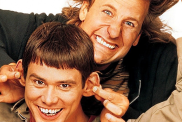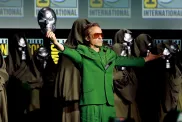A look at 15 of the greatest horror and fantasy films directed by maverick filmmaker and producer Roger Corman
With the trailer for the now 90-year-old independent filmmaking maverick Roger Corman‘s latest go-for-broke, genre mash up Death Race 2050 released last week, we thought it a fine time to look at the handful of feature films the producer/mogul has actually directed and pull out 15 of our favorites.
In case you aren’t savvy, Roger Corman has made hundreds of films and launched the careers of a legion of successful filmmakers and actors. We can, in fact, credit Roger Corman with the birth of the American New Wave in the late 1960s and early 1970s. Scorsese, Nicholson, Towne, Coppola and many more learned their trade by working for and with Corman and later, his producing partner and wife (and trailblazer in her own right), Julie Corman. Born in Detroit in 1926, it seemed Corman was destined to become an engineer, but a nagging interest in film. literature and fine arts made the young man stray and, after getting a job in the 20th Century Fox mail room, eventually – through a series of complicated adventures illustrated in the many films and books about his life and work – established himself as an independent producer specializing in genre fare targeting the burgeoning “teenage” market of the 1950s and early ’60s.
RELATED: Roger Corman remembers his 1959 classic A Bucket of Blood
Corman would become American International Pictures in-house director and with them, he would lead the way in making movies economically and intelligently. Later, he would start his own studio, New World, an imprint that defined the 1970s lust for harder, sexier and violent indie fare and still later Concorde and New Concorde. But Corman was also a director specializing in horror and fantasy and history rightly cites him as one of the finest of his kind. The films Corman directed – especially his internationally celebrated and hugely influential “Poe” movies – are ripe with wit, casual style and a most likely time-sensitive spurred urgency and almost all of them bear traces of his intellect, his sophistication and sense of culture as well as his interest in classic literature and painting (even now, the ever-active Corman still paints regularly, though many fans are not even aware of this).
So here, today, in this space, we celebrate Corman the director. Have a look and, if you have yet to discover the incredible, storied and often amusingly insane, creative world of Roger Corman, every film om this list is easily available and ready to be admired.
Roger Corman List
-
Attack of the Crab Monsters (1957)

Derided by some for its crudeness, Attack is a no-budget wonder, akin to The Thing, with monstrous mutant crabs eating and imitating their human prey. Sure it's silly. But there's a nightmarish quality to the film, almost accidentally surreal. And sci-fi actor and Gilligan's Island legend Russell Johnson is quite good. One of Corman's greatest early period films.
-
A Bucket of Blood (1959)

Corman and writer Charles B. Griffith's late out of the gate skewering of Beatnik culture is hilarious and macabre, with hints of Corman's interest in the works of Edgar Allan Poe. Dick Miller gives a career defining performance as nebbish Walter Paisely, who dupes the world into thinking he's an artist by coating his murder victims in clay. Razor sharp and outrageous, this cheap and cheerful shocker might just be Corman's best film.
-
The Wasp Woman (1960)

Another Corman quickie, this is actually an intelligent and proto-feminist horror film, a criticism of the corporate brainwash to exploit female vanity. Susan Cabot plays a cosmetics company baroness who uses enzymes from honey bee jelly to reverse her obvious aging and instead turns into a were-wasp, sucking blood and terrorizing her victims. Corman quickies of this period had an inimitable energy (and that great Fred Katz jazz!) and The Wasp Woman feels almost like a wicked guitar solo. Love it!
-
The Little Shop of Horrors (1960)

Shot in three days, this is the 2nd of the 3 Corman/Griffith comedic horror films (the first being Bucket of Blood, the third 1961's Creature From the Haunted Sea) and it's ingeniously mounted and playfully executed, with amazing Fred Katz jazz to keep the lurid tale of skid row dreams and man-eating plants bouncy. Later a musical and then a deluxe 1986 film directed by Frank Oz. Nothing beats the original, though...
-
House of Usher (1960)

Corman famously convinced his bosses at AIP to pour the money they would normally put into two black and white quickies and instead make a single full-color "elevated" horror film., The result was this RIchard Matheson-penned, Hammer-esque wonder that cemented Corman's relationship with actor Vincent Price. Floyd Crosby's economical photography is stunning, Danny Haller's production design disarming, Les Baxter's music lush and Corman's direction intense. The literature loving director was clearly enjoying every minute of making this more sophisticated sort of film.
-
The Pit and the Pendulum (1961)

While House of Usher was relatively restrained, the similarly plotted, Matheson-penned expansion of the Poe story is unhinged and demented. It's a masterpiece of course, with Haller's incredible production design providing the canvas for Corman and Vincent Price to paint their wild fever dream of adultery and madness. Barbara Steele appears memorably but, like in her Italian films, is dubbed. And that climax! Wow!
-
Tales of Terror (1962)

Corman and Matheson's anthology Poe film is fun, if unfocussed. When it's on, however, it's bang-on, and best of all, once more gives Corman the chance to flex his comedic muscles. The second story, an expansion of Poe's The Black Cat, is rightly beloved, with Peter Lorre's loutish brute bouncing comically off Price's affected wine expert and Joyce Jameson's frazzled housewife. The entire film is a joy, but The Black Cat story is the spine of the picture.
-
The Intruder (1962)

Famously, one of the few movies made during Corman's heyday in which he lost money, this Charles Beaumont scripted indictment of racism is unforgettable and offers William Shatner's best performance. He's a white supremacist who breezes into town and tries to whip the locals into a frenzy, urging them to attack their black neighbors. A stunning, raw piece of work.
-
The Premature Burial (1962)

This entry in the Poe cycle has an interesting history, with Corman stepping away from AIP to make his own Poe film (Ray Milland replaced Price who was under contract from AIP). When AIP studio heads Sam Arkoff and James Nicholson found out, they didn't like this and resorted to thug tactics to suck the film back into their world. Milland is no Price but this is one of Corman's most serious, gloomy and atmospheric films, with elegant Floyd Crosby photography and haunting music by Les Baxter and Ron Stein.
-
Masque of the Red Death (1964)

The second-to-last Poe/Corman film, Masque is Corman's "Bergman" movie, ann arthouse existential medieval drama/morality tale with the skin of a horror movie. Vincent Price shines as Prince Prospero, David Lee's music is thundering and the British locations and crew (Nicolas Roeg shot the film) add theatrical richness to this intensely directed picture. A genuine masterpiece.
-
Tomb of Ligeia (1964)

The final Poe/Corman picture, penned by Robert Towne, shot in a genuine crumbling abbey on Norfolk, England and featuring Price in one of his most compelling and controlled performances. While not as operatic as the delirious Masque, Ligeia is still a compelling tale of Gothic obsession and drips with atmosphere and dread.
-
The St. Valentine's Day Massacre (1967)

Violent and rousing gangster drama with a stellar cast (Jason Robards and Bruce Dern are great) based on the true massacre in 1929, executed on orders by Al Capone. Shot almost entirely on the Desilu studios backlot, the film feels like a full-color 1940's noir and is directed with urgency and no-nonsense flair.
-
The Trip (1967)

A nice companion to the psychedelic The Monkees movie Head, The Trip was similarly written by Corman protege Jack Nicholson. It's even more "heady". The film is also the blueprint for Easy Rider, with Peter Fonda, Dennis Hopper and Nicholson working together to tap into the late '60s counter-culture. Corman himself took acid so he could fully understand his subject matter. The movie is visionary.
-
Bloody Mama (1970)

Following the groundbreaking success of Arthur Penn's depression-era gangster film Bonnie and Clyde, Corman's Bloody Mama ups the blood and gives us a majestic performance by Shelley Winters. Winters plays gangster matriarch Ma Barker who uses her uncouth brood (one of her sons is played by Robert De Niro) to blaze a trail of murder and theft across America in the 1920s. Sexual and deranged, Corman has cited this as one of his personal favorites and its a dirty, stylish blast.
-
Frankenstein Unbound (1990)

The last Corman-directed feature film to date, the unjustly maligned film features a returning-to-the-chair Corman fully engaged and full of energy. The wigged-out Brian Aldiss tale is effectively "New World-ed" to become sexier and stranger, with a great cast including Raul Julia, John Hurt and Bridget Fonda (honoring her father's early relationship with Corman) clearly delighted to be making mad movies with the master. Give Frankenstein Unbound another try...










